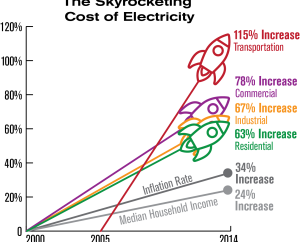An overview of the construction of a microbial fuel cell
A bio-electrochemical framework that changes over substance energy of natural mixtures or sustainable power to electrical energy or bio-electrical energy through the microbial synergist response at the anode is called Microbial Fuel Cell (MFC).
It is another option and appealing innovation to create power from wastewater treatment or modern squanders. It utilizes microbes to straightforwardly switch natural matter over completely to electrical Electricity Rates in Houston . It is viewed as another strategy to recuperate sustainable power.
Development of Microbial Fuel Cell
The microbial fuel cell innovation is utilized to change over compound energy into electrical energy by the oxidation interaction of natural squanders and a few carbon sources. The different parts associated with the development of microbial fuel cell innovation are anode and cathode chambers, organisms, trade layers, substrates, terminals, and an electrical circuit to create power.
The anode and cathode offices of MFC are comprised of glass, plexiglass, and polycarbonate material. The materials like carbon paper, carbon fabric, and graphite are utilized as anode cathodes. To keep up with the terminal’s vigorous nature, an air cathode is utilized and it is comprised of pl-dark impetus material or platinum material.

In the MFC innovation, most of the microbial populace has a place with the Shewanella and Geobacter species. To create power, photosynthetic microscopic organisms are utilized really. Blended bacterial societies are utilized in MFC, for example, normal microbial networks, marine and lake dregs, homegrown wastewater, and brewery wastewater.
To create power, the substrates like acetic acid derivation, glucose, propionate, and butyrate are utilized in MFC. In the bio-power age, different natural substrates are utilized, which are engaged with anaerobic movement by the microorganisms.
To deliver constant power, homegrown wastewater is utilized successfully. For most extreme power thickness creation pig wastewater; For bio-power and hydrogen creation – squander slime; For bio-power age – oil wastewater.
The development of Microbial Fuel Cell innovation relies upon its plan. There are two plans of MFC, for example, single-Chambered MFC and Double or Two-chambered MFC.
Single-Chambered MFC
This microbial fuel cell configuration contains just a single anode chamber and it is combined with an air cathode to move the protons and electrons. It is worked in either persistent mode or clump mode.
Two-chambered MFC
An exemplary kind of innovation comprises two or double chambers, which are isolated by a trading layer. It runs in clump mode and works in constant mode. This MFC configuration is generally utilized in research facilities. To produce power, it involves acetic acid derivation or glucose as a substrate. It is accessible in the round and hollow, rectangular, upflow with tube-shaped, smaller than expected, and U-molded cathodes.
Benefits
The benefits of Microbial Fuel cell innovation are given beneath.
- This innovation can create power from biowastes and natural matter.
- It can switch the energy of the substrate over completely to electrical energy/power.
- Air circulation
- Exclusion of gas treatment
- Bioremediation of poisonous mixtures.
Inconveniences
Coming up next are the inconveniences of Microbial Fuel Cell Innovation
- The created power thickness is low.
- Over-the-top expensive
- Enactment misfortunes and ohmic are available
- Metabolic misfortunes of microscopic organisms.
Applications
A couple of Microbial Fuel cell applications are recorded underneath.
- Utilized in the age of power or power and bio-power.
- Utilized in biosensor
- Utilized in biogas
- Utilized in the treatment of wastewater
- Utilized in different bio-fuel applications like gases.
- Utilized in the desalination cycle
- Utilized underway of auxiliary fuel
- Utilized as a schooling device.

